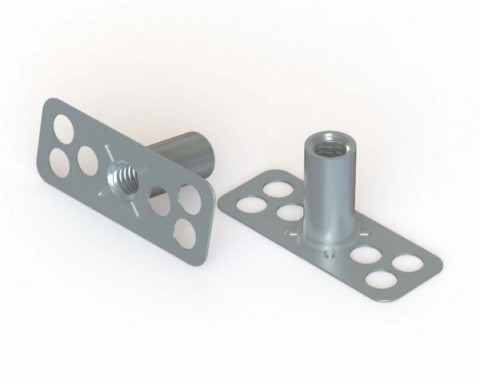Bonding fastener
Our bonding fasteners offer reliable threaded connections for composite panels, sandwich structures, and insulation materials — without drilling or damaging the surface.
With over 28 years of experience, Juno Industries provides fastening solutions that combine strength, precision, and durability.
What Is a Bonding Fastener?
Definition and Working Principle
A bonding fastener is a metal insert with an internal or external thread, designed to be bonded to a surface using adhesive instead of being mechanically screwed in.
Its base (often perforated or structured) allows the adhesive to flow through and create a strong mechanical and chemical bond.
Available Types of Bonding Fasteners
-
Bonding studs / male fasteners
-
Bonding nuts / female fasteners (with or without perforations)
-
Bonding spacers and collars
-
Insulation pins and anchors
-
Custom-made bonding inserts
-
Optional accessories: mixing nozzles, adhesive dispensers, and epoxy kits
Why Choose a Bonding Fastener?
Main Advantages
-
No drilling, welding, or heat distortion
-
Perfect for lightweight composite or sandwich materials
-
Even stress distribution across the bonded area
-
Excellent resistance to vibration and corrosion (depending on material)
-
Quick installation and aesthetic surface finish
Typical Applications
-
Composite structures (fiberglass, carbon fiber, honeycomb)
-
Sandwich panels and insulation boards
-
Marine, automotive, aerospace, and construction industries
-
Areas where drilling or through-fixing is not possible
How to Select the Right Bonding Fastener
1. Internal Thread Size
Match the fastener to your bolt or threaded rod — typically M4 to M10 depending on the load and material thickness.
2. Base Design and Geometry
-
Perforated base: maximizes adhesive penetration and grip
-
Flat or domed base: depends on surface shape and adhesive volume
-
Height and diameter: adapt to the available bonding surface and load capacity
3. Material Choice
-
Stainless steel (A4 / 316): excellent corrosion resistance for marine or outdoor use
-
Zinc-plated steel: economical indoor applications
-
Brass: prevents galling when combined with stainless-steel screws
-
Custom alloys: available for specific environments (chemical or high-temperature)
Installation Guide – Step by Step
Surface Preparation
Clean, degrease, and lightly abrade the surface to improve adhesion. Ensure it is dry and free from dust or contaminants.
Bonding Process
-
Select a suitable two-component or epoxy adhesive.
-
Apply adhesive evenly under and through the fastener base.
-
Position the bonding fastener carefully and press firmly.
-
Allow the adhesive to cure fully before applying any load.
Quality Check
After curing, check alignment and bonding strength before tightening bolts or screws.
Benefits of Juno Industries Bonding Fasteners
Key Strengths
-
High-quality materials and precision manufacturing
-
Reliable load capacity even in thin or soft materials
-
Large product range (studs, nuts, collars, custom inserts)
-
Technical advice tailored to your application
-
Fast delivery across Europe
Added Services
-
Free samples for testing and validation
-
Low minimum order quantities (100 pcs standard, 50 pcs for M10+)
-
Technical support for adhesive selection and installation
















